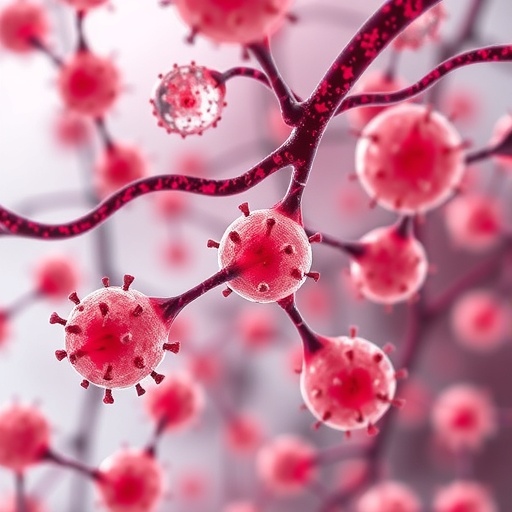In an era where the quest for effective treatments against liver fibrosis has become a paramount challenge in medical research, a groundbreaking study from Liu et al. offers a beacon of hope. Their recent publication in Nature Communications unveils an innovative therapeutic approach leveraging nucleic acid spheres to combat the capillarisation of liver sinusoidal endothelial cells (LSECs), a critical pathological event driving the progression of liver fibrosis. This pioneering research not only advances our understanding of LSEC biology but also introduces a novel platform with the potential to revolutionize fibrosis therapy.
Liver fibrosis, characterized by excessive deposition of extracellular matrix components, leads to the disruption of normal hepatic architecture and function. Central to this process is the phenomenon of capillarisation, where specialized fenestrated LSECs lose their unique morphology and transform into a continuous, capillary-like endothelium. This transformation impairs the highly selective filtration function of LSECs, contributing to the progression of liver fibrosis and, ultimately, cirrhosis. Understanding and reversing this capillarisation have been long-standing objectives, as the restoration of LSEC function could halt or even reverse fibrotic progression.
The research team led by Liu, W., Liu, Y., and Zhang, L. engineered nucleic acid-based spherical nanoparticles designed to intervene in the cellular pathways that govern LSEC capillarisation. Unlike conventional small molecules or antibody therapies, these nucleic acid spheres offer a multifaceted mechanism of action: they can be programmed to deliver specific sequences capable of modulating gene expression, interfering with pathological signaling cascades, and promoting cellular reversion to a healthy phenotype. Their unique spherical configuration enhances stability and cellular uptake, bypassing many shortcomings encountered by traditional nucleic acid therapies.
At the molecular level, it is well understood that capillarisation is driven by aberrant activation of pro-fibrotic signaling pathways, including those mediated by transforming growth factor-beta (TGF-β), vascular endothelial growth factor (VEGF), and Notch signaling. These pathways collectively promote endothelial dedifferentiation, loss of fenestrae, and basement membrane deposition. The nucleic acid spheres are designed to target key molecules within these signaling networks, thereby attenuating fibrotic signaling and restoring the fenestrated phenotype characteristic of healthy LSECs.
A particularly novel aspect of Liu et al.’s strategy is the ability of nucleic acid spheres to penetrate the liver sinusoidal environment efficiently. The unique size and surface chemistry of these spheres facilitate their selective uptake by LSECs, minimizing off-target effects and potential systemic toxicities. This selective targeting is crucial, considering the liver’s complex cellular heterogeneity and the unique fenestrated morphology that defines LSECs. Effective delivery to these cells has previously been a formidable barrier to therapeutic development.
Their in vitro experiments demonstrated remarkable efficacy in reversing capillarisation markers in cultured LSECs subjected to fibrotic stimuli. Upon treatment with nucleic acid spheres, LSECs exhibited restored fenestrae structures, reduction in basement membrane proteins, and downregulation of endothelial-to-mesenchymal transition markers. These morphological and molecular changes indicate a functional reversion towards a healthy endothelium, an encouraging endpoint rarely achieved by previous interventions.
Moving beyond cell culture, the team validated their approach in murine models of liver fibrosis induced by carbon tetrachloride and bile duct ligation. Systemic administration of nucleic acid spheres resulted in significant improvements in liver histology, marked decreases in collagen deposition, and restored endothelial fenestration as assessed by electron microscopy. Functional assays revealed improved hepatic perfusion and metabolic function, linking the morphological restoration directly to improved liver physiology.
The implications of this study extend well beyond the realm of experimental therapeutics. By showcasing the potential of nucleic acid nano-constructs as precise modulators of endothelial function, Liu et al. open avenues for addressing a wide range of vascular pathologies characterized by endothelial dysfunction. Importantly, these spheres are customizable, suggesting a versatile platform that can be adapted for various disease contexts, including other fibrotic diseases, vascular malformations, and perhaps even tumor vasculature normalization.
Central to the success of this approach is the careful design of the nucleic acid spheres to resist nuclease degradation, a major limitation in nucleic acid therapeutics. The authors employed chemical modifications of nucleotides and a controlled self-assembly process to generate spheres stable under physiological conditions. This stability ensures sustained bioavailability and effective biological activity, overcoming a significant hurdle in the translation of nucleic acid therapies.
Another innovation lies in the interactivity of the nucleic acid spheres with the intracellular machinery of LSECs. Beyond delivering inhibitory RNA sequences, these spheres act as scaffolds, recruiting endogenous regulatory proteins that amplify anti-fibrotic signaling. This multi-layered mode of action potentiates therapeutic outcomes, rendering the approach both robust and adaptable.
The safety profile reported by Liu et al. is equally encouraging. Comprehensive toxicology studies showed no significant off-target immune activation, hepatotoxicity, or systemic adverse effects at therapeutically effective doses. Given the immunogenic risk often associated with nanoparticle-based therapies, this finding paves the way for clinical translation, underscoring the biocompatibility of the nucleic acid sphere platform.
Clinical translation remains a critical future step. The team outlines strategies to scale up nucleic acid sphere production under Good Manufacturing Practice (GMP) conditions and plans to initiate early-phase clinical trials targeting patients with early-stage liver fibrosis. If successful, this therapy could shift the treatment paradigm from symptom management to direct disease modification, a transformative advancement in hepatology.
The impact of Liu et al.’s research resonates within the scientific community and beyond. The use of nucleic acid nanotechnology to orchestrate endothelial cell phenotypes represents an elegant convergence of molecular biology, nanomedicine, and vascular biology. It challenges the traditional confines of drug design and opens the playing field for sophisticated biological interventions tuned at the genomic and proteomic levels.
Moreover, the study highlights the importance of targeted delivery in overcoming biological barriers intrinsic to complex organs such as the liver. By refining cellular specificity and enhancing intracellular trafficking, therapeutic nucleic acid spheres embody the next generation of precision medicine aimed at tackling chronic, otherwise intractable diseases.
The methodology and findings of Liu and colleagues also inspire future research directions. The utility of nucleic acid spheres could extend to other endothelial subtypes and fibrotic models, and their modular nature suggests integration with emerging gene editing tools, such as CRISPR-Cas systems, to further refine therapeutic precision.
Finally, these findings underscore the essential role of interdisciplinary collaboration in advancing biomedical innovation. The marriage of nucleic acid chemistry, vascular biology, and nanotechnology exemplified in this study demonstrates how convergent science can unlock new therapeutic frontiers.
Subject of Research: Treatment of capillarisation of liver sinusoidal endothelial cells in liver fibrosis using nucleic acid spheres
Article Title: Nucleic acid spheres for treating capillarisation of liver sinusoidal endothelial cells in liver fibrosis
Article References:
Liu, W., Liu, Y., Zhang, L. et al. Nucleic acid spheres for treating capillarisation of liver sinusoidal endothelial cells in liver fibrosis.
Nat Commun 16, 4517 (2025). https://doi.org/10.1038/s41467-025-59885-x
Image Credits: AI Generated
Tags: capillarisation in livercellular pathway intervention in fibrosiscirrhosis prevention strategiesextracellular matrix depositionhepatic architecture disruptioninnovative fibrosis therapyliver fibrosis treatmentliver sinusoidal endothelial cellsLSEC biology advancementsnucleic acid spheresreversing liver fibrosis progressiontherapeutic nanoparticles for liver disease





